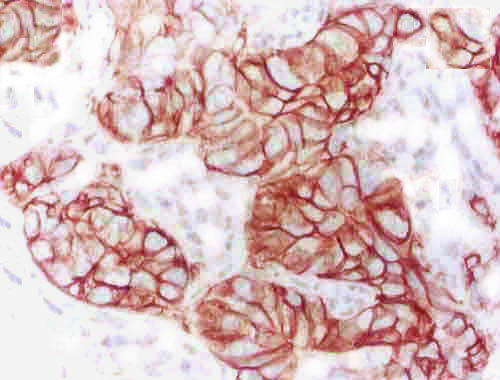Monoclonal antibodies directed against rat tumor antigens of epithelial origin

"Binding of CC52 monoclonal antibodies to rat colorectal
metastases in paraffin-embedded liver tissue"
Hybridoma Clone Antibody Isotype Cat. No.
CC52 Mouse IgG1 ARA01
Generation
These monoclonal antibodies have been raised by immunization of mice with rat colon adenocarcinoma cells (CC531). Hybridomas were selected for producing antibodies reacting with the CC531 cell line and with minimal cross reactivity to normal tissues (Hagenaars et al., 2001). CC52 belongs to a first generation of such antibodies and is very useful to detect tumor cells by immunohistochemistry.Reactivity
CC52 is a rat strain-independent marker for tumor cells of epithelial origin, like in colon, breast, or lung cancer, etc. When injected in colon tumor-bearing rats, CC52 localized to tumor cells (Hagenaars et al., 2001). CC52 can be used for immunohistochemical staining of tumor cells in frozen tissue sections as well as formalin-fixed/paraffin-embedded tissue. CC52 is also suitable to be used in flow cytometry, Western blotting, immunoprecipitation, and ELISA.Technical information
The monoclonal antibody binds to two proteins, 120 kD and 130 kD, expressed by rat tumor cells of epithelial origin. CC52 has been used in many studies in a rat model of colorectal cancer (e.g. Hagenaars et al., 2000). In immunohistochemical stainings, there is some background in intestine epithelial tissue and bile ducts. Citric acid pretreatment is recommended for formalin-fixed/paraffin-embedded tissue sections. The antigens detected by CC52 are also expressed by IL-2-activated cultured NK cells and T cells and by bone marrow cells. CC52 can also be used in Western blotting. In addition, there is a bispecific antibody available (R73xCC52, ARA17) that consists for one half of this antibody and the other half of an antibody directed against the rat T cell receptor. This bispecific antibody is able to induce T cell to lyse tumor cells.References
Hagenaars M, Ensink NG, Basse P, Hokland M, Nannmark U, Eggermont AM, Van De Velde CJ, Fleuren GJ, Kuppen PJ (2000) The microscopic anatomy of experimental rat CC531 colon tumour metastases: consequences for immunotherapy? Clin Exp Metastasis 18: 189-196 Hagenaars M, Ensink NG, Van Eendenburg JD, Van Vlierberghe RL, Eggermont AM, Van De Velde CJ, Fleuren GJ, Kuppen PJ (2001) The development of novel mouse monoclonal antibodies against the CC531 rat colon adenocarcinoma. Clin Exp Metastasis, 18: 281-289Ordering Information